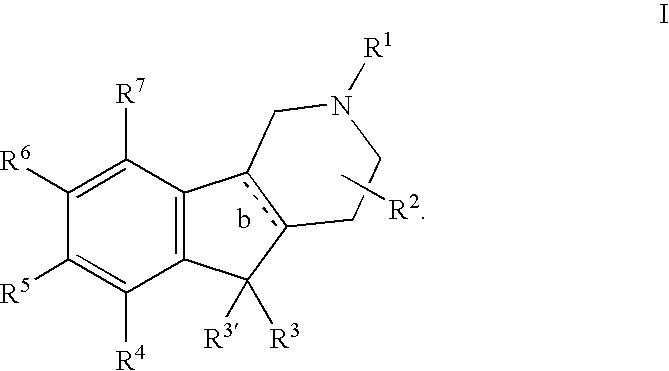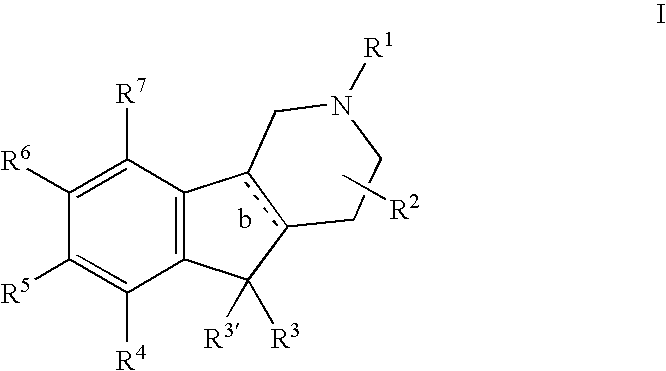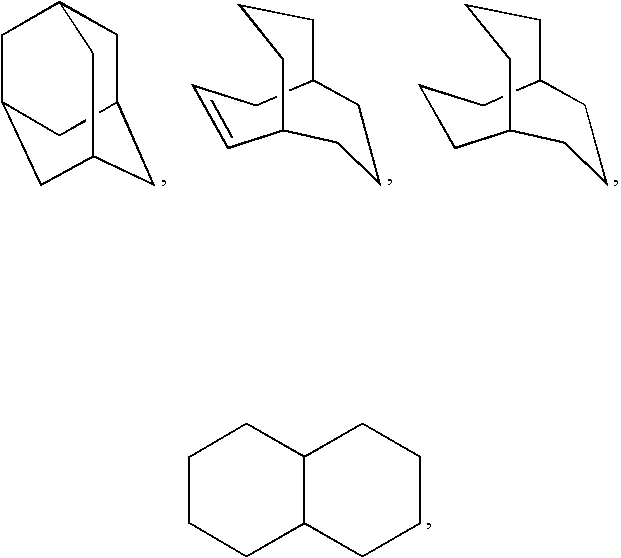Substituted tricyclic heterocycles as serotonin receptor agonists and antagonists
a tricyclic heterocycle and serotonin receptor technology, applied in heterocyclic compound active ingredients, biocide, organic chemistry, etc., can solve problems such as side effects and breakthrough treatments, but not without side effects
- Summary
- Abstract
- Description
- Claims
- Application Information
AI Technical Summary
Problems solved by technology
Method used
Image
Examples
example 1
cis-3-Benzyl-6-bromo-1,2,3,4,4a,9a-hexahydro-3-aza-fluoren-9-one
[0128]
[0129] Step A. To a solution of 1,3-dibromobenzene (2.36 g, 10.0 mmol) in THF (20 mL) was added Mg (264 mg, 11.0 mmol) and 1,2-dibromoethane (8 μL) at 20° C. The reaction mixture was stirred for 1 h at 20° C. to give (3-bromophenyl)magnesium bromide as a clear 0.5 M THF solution.
[0130] Step B. A 0.5 M THF solution of (3-bromophenyl)magnesium bromide (20 mL, 10 mmol) was cooled to −15° C., and methyl 1-benzyl-1,2,3,6-tetrahydropyridine-4-carboxylate (1.05 g, 4.3 mmol) in toluene (3.0 mL) was slowly added for 3 h at −15° C. The reaction mixture was warmed to 20° C. and quenched by addition of saturated NH4Cl aqueous solution followed by extraction with EtOAc. The combined organic solution was dried over MgSO4, filtered and concentrated in vacuo. The residue was chromatographed in silica gel column (Hex / EtOAc 9 / 1) to give methyl 1-benzyl-3-(3-bromophenyl)piperidine-4-carboxylate (1.0 g, 2.6 mmol).
[0131] Step C. A ...
example 2
cis-3-Benzyl-8-bromo-1,2,3,4,4a,9a-hexahydro-3-aza-fluoren-9-one
[0132]
[0133] The title compound (608 mg, 1.7 mmol) was obtained from the step C of example 1 as the more polar fraction to the region-isomer example 1: MS (ES) 356.1 (M+H).
example 3
cis-3-Benzyl-6-(2,4-dichloro-phenyl)-1,2,3,4,4a,9a-hexahydro-3-aza-fluoren-9-one
[0134]
[0135] (280 mg, 0.79 mmol), 2,4-dichlorophenylboronic acid (181 mg, 0.95 mmol), barium hydroxide octahydrate (374 mg, 1.2 mmol) and triphenylphosphine (21 mg, 0.079 mmol) were dissolved in DMF (6.0 mL) / H2O (1.2 mL), and the solution was degassed. To the solution was added palladium(II) acetate (4.4 mg, 0.020 mmol), and the reaction mixture was heated at 90° C. for 15 h under Ar. The reaction mixture was cooled to 20° C. and diluted with CH2Cl2. The organic layer was washed with brine, dried over MgSO4, filtered and concentrated in vacuo. The residue was chromatographed in silica gel column (Hex / EtOAc 7 / 3) to obtain the title compound (132 mg, 0.31 mmol): MS (ES) 422.1 (M+H).
PUM
| Property | Measurement | Unit |
|---|---|---|
| pH | aaaaa | aaaaa |
| pH | aaaaa | aaaaa |
| pH | aaaaa | aaaaa |
Abstract
Description
Claims
Application Information
 Login to View More
Login to View More - R&D
- Intellectual Property
- Life Sciences
- Materials
- Tech Scout
- Unparalleled Data Quality
- Higher Quality Content
- 60% Fewer Hallucinations
Browse by: Latest US Patents, China's latest patents, Technical Efficacy Thesaurus, Application Domain, Technology Topic, Popular Technical Reports.
© 2025 PatSnap. All rights reserved.Legal|Privacy policy|Modern Slavery Act Transparency Statement|Sitemap|About US| Contact US: help@patsnap.com



